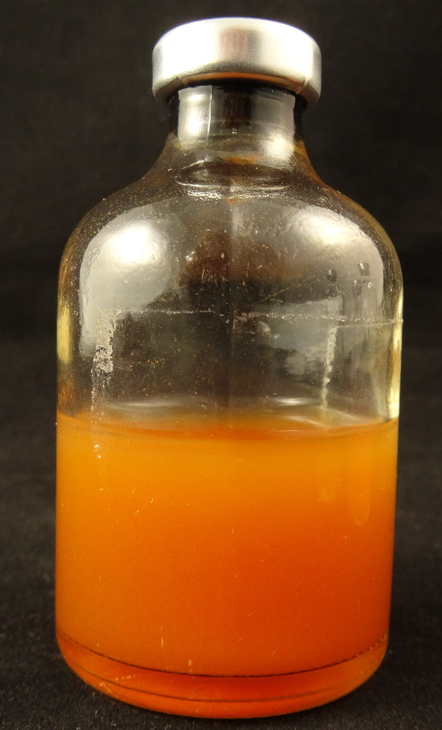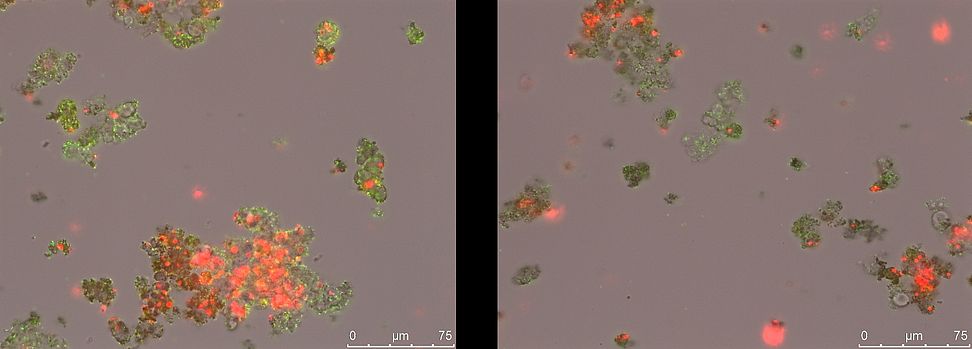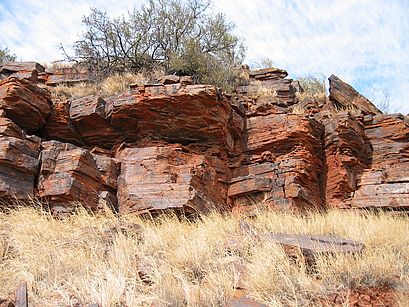Early in the Earth's development, the atmosphere contained no oxygen. Yet the iron dissolved in the oceans was oxidized in gigantic quantities and deposited as rock. It can be seen today, for example, as banded iron ore in South Africa. A new study investigates how various bacteria excrete insoluble iron as part of their metabolic processes. Some - the phototrophic iron oxidizers - gain energy by oxidizing the iron with the help of sunlight, and others by reacting the iron with nitrate as an oxidizing agent. An international research team including Dr. Casey Bryce from the University of Bristol and Dr. Verena Nikeleit and Professor Andreas Kappler, geomicrobiologists at the University of Tübingen, examined these processes and asked: Which microbes had the upper hand in the competition for the iron? The rival bacteria also used nitrogen monoxide, a toxic gas. The study has been published in the journal Nature Geoscience.
Two to three billion years ago, the composition of the Earth's atmosphere was completely different. "The oceans at that time contained vast quantities of iron in its reduced form. Under today's conditions, it would have been quickly oxidized by the oxygen in the atmosphere to form rusty iron minerals," explains Andreas Kappler. Although there was no oxygen during this early phase on Earth, huge rock deposits of iron show that microbes were oxidizing it effectively even then.
Experiments in the lab
"Before there was oxygen on Earth, phototrophic iron oxidizers formed the huge iron oxide deposits known today as banded iron ores," says Dr Casey Bryce, head of the project. Formerly of the University of Tübingen, Bryce is now a Senior Lecturer at the University of Bristol School of Earth Sciences. "We wanted to know whether these bacteria were in competition with other iron oxidizers that used nitrate," she adds. This led to the questions of whether these competing microbes could actually coexist, and if so, which of them were primarily responsible for iron oxidation.
"In order to better understand the situation on early Earth, we conducted laboratory experiments," says Verena Nikeleit, who since the study has moved to the Norwegian research center NORCE. The research team used one bacterial strain of each of the different iron oxidizers and allowed them to grow under the conditions that prevailed two to three billion years ago, in the light and with the same concentrations of iron, nitrate and carbon dioxide. "To our surprise, the nitrate was quickly used up and the iron was oxidized. But we could not detect any iron oxidation by the phototrophic iron oxidizers," says Nikeleit. The analyses showed that the nitrate-consuming iron oxidizers formed nitrogen monoxide as a toxic by-product. "This brought the activity of the phototrophic iron oxidizers to a complete standstill. In other words, these microbes killed the phototrophic iron oxidizers by producing a poisonous gas."
A complex network of interactions
"One hypothesis is that the phototrophic iron oxidizers probably contributed very little to the formation of banded iron ores in later phases of the Earth's history," says Andreas Kappler. This is because the activity of other microbes caused the Earth's atmosphere to contain increasingly more oxygen - a kind of early major environmental pollution event. "This may also have reached some areas of the oceans where nitrate could then be formed as a result. Our results provide the first experimental evidence for the hypothesis that phototrophic iron oxidizers in areas of high productivity may have been exposed to toxic nitrogen monoxide during this time. They must have moved further away from the nutrient-rich areas and were therefore not able to deposit as much iron."
According to Casey Bryce, by the research team's calculations iron oxidation by nitrate-reducing bacteria may have initially compensated for the reduced contribution of phototrophic iron oxidizers. "So the initial competition between the different bacteria would not immediately stop the formation of the banded iron formations," she says. Further measurements and investigations are needed to get a more precise picture of the processes. "Our study provides an insight into how the oxygen enrichment of the Earth's atmosphere could have affected other nutrient cycles in the oceans. This illustrates the complex network of biogeochemical interactions that controlled life in the Earth's early oceans," Bryce says.
Publication:
Verena Nikeleit, Adrian Mellage, Giorgio Bianchini, Lea Sauter, Steffen Buessecker, Stefanie Gotterbarm, Manuel Schad, Kurt Konhauser, Aubrey L. Zerkle, Patricia Sanchez-Baracaldo, Andreas Kappler, Casey Bryce: Inhibition of phototrophic iron oxidation by nitric oxide in ferruginous environments. Nature Geoscience, https://doi.org/10.1038/s41561-024-01560-9









